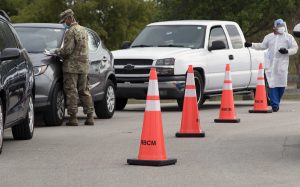This post is part of a series on the convergence of COVID-19 and weather/climate. Each post covers only part of the complex, evolving situation we all are trying to prepare for, respond to, and learn from. Therefore, any recommendations should be considered within your individual geographic, economic, and social context.

Hunter Spitzer and the Convergence Team. April 9, 2020
It has been over three weeks since COVID-19 upended life in the United States. Cleaning products have become scarce and personal protective equipment for medical personnel is in short supply around the world. Grocery and big box stores are struggling to meet the surge in demand as people prepare to spend extended periods of time at home. At least forty-two states have implemented stay-at-home orders of some kind, and there are calls from national authorities to maintain this level of physical isolation beyond April 30th. With the COVID-19 pandemic threatening lives on a daily basis, it is difficult to consider the weather hazards we might face in the coming weeks.
April marks the beginning of severe weather season. Across the Southeast (AL, FL, GA, NC, SC, VA, & Puerto Rico), there are on average 28 tornadoes in the month of April based on reports from 2000-2018, and 219 incidents of severe weather (hail, high winds). Severe weather causes damages to homes, vehicles, and infrastructure, power outages, and if not prepared for, can also cause loss of life. It is important to react to a tornado as you would under non-COVID-19 circumstances. For those who continue to work essential jobs and visit the grocery store weekly, precautions for seeking refuge from a tornado take precedence over physical distancing. Everyone must be prepared for possible power outages, which can occur after tornadoes or high wind events, to last longer than usual if some repair crews have taken sick leave or been laid off. On the other hand, the closure of non-essential businesses may have some benefit as seen when a tornado tore through the downtown of Jonesboro, Arkansas. Few people were injured largely due to the closure of most of the businesses in the area.
April also marks the beginning of hurricane preparedness in the Southeast US. Emergency planners have quickly realized how COVID-19 will impact their preparations for this coming hurricane season. The cancellation of the National Hurricane Conference and the Florida Governor’s Hurricane Conference, for example, has halted opportunities to learn from experiences of the past season and new best-practice techniques. There are further concerns about the operations of hurricane shelters, which cannot be opened under physical distancing guidelines. Disaster consultants are worried that FEMA may already be overwhelmed, and that the typical support received from non-profit organizations and neighboring municipalities for post-disaster recovery may be less forthcoming. Although it is difficult to predict just how impactful each hurricane season will be, it is important to always be prepared for an active season.
Weather can hinder the US response to the pandemic in more subtle ways. As testing began in Tampa, FL, healthcare workers set up drive-through testing stations. While these are convenient for residents, it is challenging for nurses who wear layers of protective gear to administer these tests while standing on unshaded asphalt throughout the heat of the day. Tampa has seen above average temperatures for the last month, like the rest of the Southeast region. Indeed, the entire region has observed above average April temperatures over the last 7 out of 10 years. As we approach heat season, health professionals and high-risk groups must be careful to avoid heat illness, which could increase susceptibility to COVID-19 and require competing medical resources. If we do our part to spread awareness of these compounding factors and maintain strict compliance of stay-at-home measures, we may see a reduction of COVID-19 cases, just as we see a change of season.
Sources:
https://www.ncdc.noaa.gov/sotc/national/202002
https://www.delmarvanow.com/story/news/2020/04/02/hurricane-season-in-june-during-coronavirus-pandemic/5111024002/
https://www.nbcnews.com/news/weather/tornado-tears-through-arkansas-city-prompting-curfew-national-guard-response-n1171356
https://www.weareiowa.com/video/weather/accuweather/weather-making-changes-in-outdoor-covid-19-testing-in-tampa/607-efb3cd88-1261-4014-af1d-9909d2ec98e1

